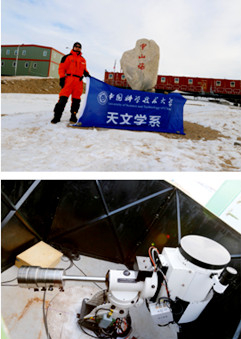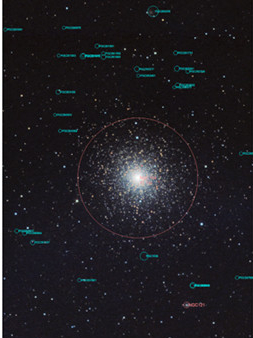First Light of BSST in Antarctica
On April 1st, the Antarctic Bright Star Survey Telescope (BSST) was installed and began trial operation. BSST is the first optical telescope at Chinese Zhongshan Station, working for test observation and helping building a maintenance and testing base for Antarctic astronomy in 1~2 years. Then the telescope will be deployed in Chinese Kunlun Station. The project comes out from the collaboration of the University of Science and Technology of China(USTC), State Key Laboratory of Particle Detection and Electronics, Chinese Center for Antarctic Astronomy (CCAA) and Polar Research Institute of China (PRIC).

Installation Spot and Observation Image
Antarctica is an excellent place for astronomical observations with unique geographical location and natural environment. The Kunlun Station is located at the highest point of the Antarctic ice plateau. Both theoretical predictions and practical measurements show that the site has one of the best observing condition among astronomical observatories on Earth. Aimed at opportunities of Antarctic astronomy, relying on beneficial conditions of Chinese Antarctic expedition platform, in 2011, Department of Astronomy of USTC led the establishment of the research team focus on “Key equipment and technologies for Antarctic observatory”.
BSST has an aperture of 300mm, a field of view of 4.8 and is equipped with a large-frame (4K×4K pixels) CCD camera. State Key Laboratory of Particle Detection and Electronics, Department of Modern Physics, USTC worked for the CCD Camera System and Remote Control System. Chinese Center for Antarctic Astronomy (Nanjing Institute of Astronomical Optics & Technology) was responsible for designing main body of telescope. Department of Astronomy, USTC finished the system integration.
The main scientific goal of BSST is searching for extrasolar planet. Taking advantage of the Antarctic that unique continuous observation window is provided by Polar night, continuous photometric monitoring on the bright stars will be performed in high latitude sky area of Southern Hemisphere, and a group of extrasolar planets on short-period orbit will be surveyed. Because of harsh natural conditions of Antarctica, telescope need great ability of environment adaptation and unattended operation.
The team led by Associate Professor WANG Jian, who is also the leader of the astronomical technology team of Institute of physics and Dr. JIANG Peng started development work from December 2013. They did research on the telescope’s remote control system, autonomously observation system and electronics system under extreme condition, under the serious challenge of Antarctic extreme low temperature and low atmospheric pressure (mean temperature of Kunlun Station at Polar night is −60, the lowest temperature is −86 with 4087m altitude and 0.5atm ) and power shortage. The whole telescope system was deployed, tested and used on scientific trial observation during April 2015 in Lijiang. On November 7th, 2015, as a member of the 32nd Chinese Antarctic Expedition Team, Dr. JIANG Peng took Xuelong Scientific Ship to the Zhongshan Station to carry out installation and observation of BSST. On April 1st, 2016, BSST got the first light at Antarctic Zhongshan Station.


Upper Panel: Globular Cluster 47 Tuc in Tucana constellation; Lower Panel: Globular Cluster ω Cen in Centaurus constellation
The project got support from Polar Research Institute of China, USTC Innovation Team Cultivation Fund, and Fundamental Research Fund for the Central Universities and National Natural Science Funds of China.
WANG Jian
Phone: +86-551-63607447
Email: wangjian@ustc.edu.cn
(WANG Jian,School of Physical Sciences)
W020160410835835678811_291_194.jpg
Back
